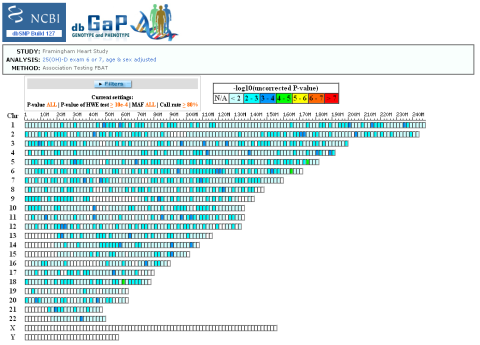This Byron quotation is taken from the foreword of Selye “Calciphylaxis” 1962 and may help to introduce the followup story on the question who described for the first time vitamin D as cofactor in the allergic sensitization process. Continue reading Tis strange – but true; for truth is always strange
Tag Archives: vitamin_d
First 25OH-D3 GWA online
The first genomewide association for vitamin D serum levels is already online as the Framingham people told me earlier this day, many thanks!
There are 3 important regions on the above figure figure: around rs1394615, rs1877165 and rs2160595, see also the attached excel sheet fram25ohdexam6or7agesexadj.xls.
What are the reasons that my linkage study arrived at completely different regions? The accompanying BMC Genetics paper even highlights 2 different SNPs: rs1048516 + rs10507577). Anyway, the best region in my opinion is on chromosome 6. Here are the significant SNPs in relation to their neighboring genes: Continue reading First 25OH-D3 GWA online
Osteopontin bridging air pollution and immunology of allergic inflammation
Ostepopontin (OPN) is a remarkable substance. The many aliases already point towards a multitude of biological functions: SPP1=secreted phosphoprotein 1, BSPI 1=bone sialoprotein-1, CIT, ETA-1, GC110940, nephropontin, osteoprotegerin, uropontin, bone sialoprotein I, early T-lymphocyte activation among others. Continue reading Osteopontin bridging air pollution and immunology of allergic inflammation
Ca2+ and IgE
Two decades ago, 10% calcium gluconate had been recommended for the treatment of anaphylaxis (couldn’t find any explanation for that but renember one of my teachers saying it will stabilize the membranes). There is now an update in scienceblog:doi:10.1038/ni1441: Continue reading Ca2+ and IgE
Vitamin D as a treatment of tuberculosis
There is now a lot of hype around the usefulness of vitamin D in the treatment of tuberculosis (scienceblog:doi:10.1164/rccm.200701-007OC ). The authors mention even their previous review (scienceblog:doi:10.1016/j.jsbmb.2006.12.052:) summarizing 13 studies between 1947 and 1998. Continue reading Vitamin D as a treatment of tuberculosis
Dont look at serum values alone
There is an ongoing discussion if 25-OH-D3 serum values can be used to diagnose vitamin D insufficiency. At least for rickets outcome there are now quantitatitive data that allow a comparison of clinical symptoms, radiological findings, cholecalciferol and alkaline phosphatase levels. I have rearranged the values of a new paper into the following figure Continue reading Dont look at serum values alone
Vitamin D and asthma
My previous work on vitamin D focused mainly on allergy but according to new research of Bosse et al vitamin D also stimulates bronchial smooth muscle and airway remodeling
Genetic variants in the vitamin D receptor (VDR) gene were recently associated with asthma. The biological mechanisms explaining this association is unknown, but are likely to involve many cell types given the pleiotropic effect of its ligand … The most significant network of up-regulated genes included genes involved in morphogenesis, cell growth and survival as well as genes encoding structural proteins, which are potentially involved in airway remodelling.
Another study published more or less at the same time by Wittke shows
Conversely, WT splenocytes, Th2 cells and hematopoetic cells induced some symptoms of experimental asthma when transferred to VDR KO mice, but the severity was less than that seen in the WT controls … Lipopolysaccharide (LPS) induced inflammation in the lungs of VDR KO mice was also less than in WT mice. Together the data suggest that vitamin D and the VDR are important regulators of inflammation in the lung…
Is “vitamin” D a biological hub?
Folllowing up numerous emails to my recent review about allergy and vitamin D exposure, I wonder if there could be a quantitative relationship if we look at the vitamin D system as a major biological hub. This is not so much about connecting different playgrounds but of integrating signals (as shown in the hourglass blog). The East-West German difference, the farming studies as well as numerous other studies would even allow a quantitative effect. Yea, yea.
Addendum
Biospektrum will publish in their next issue a summary of the vitamin D story.
Addendum
4-07-2007 The list of vitamin D dependent genes that are associated with allergy (IL12B, IL12RB, SPP/OPN, CD14, CD23, VDR, TNF, GC, IFN, IL1RN, IL8, ADRB2, CARD15, IL4R, ALOX5, FLG, SOCS3) is expanding: TSLP and CD86
